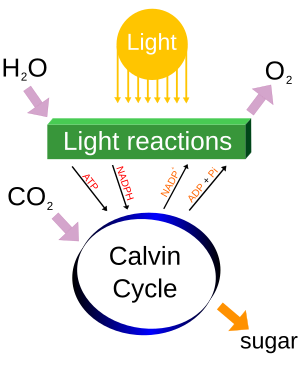
- Image via Wikipedia
Theoretical models suggest ways for optimizing artificial photosynthesis to turn light into energy the way plants do
Plants take advantage of quantum mechanics to harvest sunlight with near-perfect efficiency—though only roughly 2 percent of that capture sunlight ultimately gets stored as chemical energy. Now scientists are studying how this light-harvesting step of photosynthesis is optimized by nature to learn how to mimic it in engineered systems for use in solar cells or artificial leaves that produce fuels directly from the sun.
Plants rely on chromophores—molecules that absorb certain wavelengths of visible light while reflecting others—to harvest energy from the sun. When sunlight hits a plant, electrons in the topmost chromophores absorb energy from incoming photons and then transfer it from the newly energized molecule to another molecule at a lower energy state. That transfer repeats itself via a chain of molecules, a cascade of rapid energy pass-offs that ultimately separates an electron from the last chromophore in the chain, which provides energy that is stored by the plant as a carbohydrate.
In this way chromophores perform three functions: they absorb energy from sunlight (acting as “acceptors”); they donate the energy they absorbed (as “donors”); and they transfer energy to another molecule (as “bridges”). Using measurements from other researchers of the intensity of photons absorbed and emitted by chromophores, chemist Jianshu Cao and his colleagues at the Massachusetts Institute of Technology developed a computer model to arrive at the ratio of acceptors, donors and bridges that optimizes the efficiency of the light-harvesting step of photosynthesis.
Read more . . .








